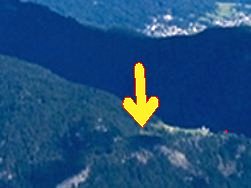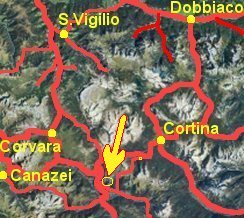The
Fanes' places: Tsicuta's home
From
the slopes of mount Pore,
near Colle Santa Lucia,
a squat spur jutts out, called Col Megon,
where pre-historical hearths have been dug out (Palmieri).
If
we have to believe Wolff,
the Megon
de Megojes, Tsicuta's
home, was a secondary top of mount Migogn, abruptly
dominating the Pettorina stream. The Migogn
is the last group of the Padon
chain towards Roccapietore. It's noteworthy, however,
that just in front of the Migogn (on the Cordevole
side, anyway) this spur named the same way can be found. Both
names can be easily connected with the Latin mecon,
poppy, directly derived from greek; as a matter of fact, the
main feature ascribed by the legend to the Megon is
just that of getting covered with red poppies, although later
on we shall discover that these are very special flowers (they
are an enigmatic allusion to the fire lit by lightning and soon
extinguished by rain). It isn't fully clarified why the former,
the latter, or both, should have drawn lightning; maybe the
effect of surface ore veins, today presumably wholly exhausted,
can be seen behind that. The mentioned pre-historic findings
increase the chance that the Col Megon may have played
a part of some importance in a remote past. Anyway, if the Megon
was located on the slopes of mount Pore, no wonder
that Ey-de-Net looked for it weeks long to no avail, as he was
combing the Migogn!
| Well
visible from: nowhere.
Better coming close. It can be noticed, however, from
the area of Caprile or from Livinallongo.
In
this image, taken from a distance (Piz
Boè!) the woody spur of the Megon
can hardly be noticed jutting out from the slopes of the
Pore; behind, on the right,is the hamlet of
Larzonei; in the background the villages
of the Fiorentina valley.
(Photo derived from a geological panoramic view in http://geopal.uni-hd.de/sediment/zuehlke/virttrip/theater/movie/01.html)
|
 |
Excursions:
the hill (Col Megon, m 1686) can easily be accessed
from the road to Larzonei, that runs close by.
From Colle Santa Lucia m 1435 or from Larzonei
m 1577, climb to monte Pore m 2405, where the
remains of the large iron mine named Fursill
can be found. The mine was already exploited in pre-historic
times; later, the bishop of Bressanone derived from it
his "Lamb iron" (so called from the brand it
was impressed with), known for its excellent quality.
|
 |
|

